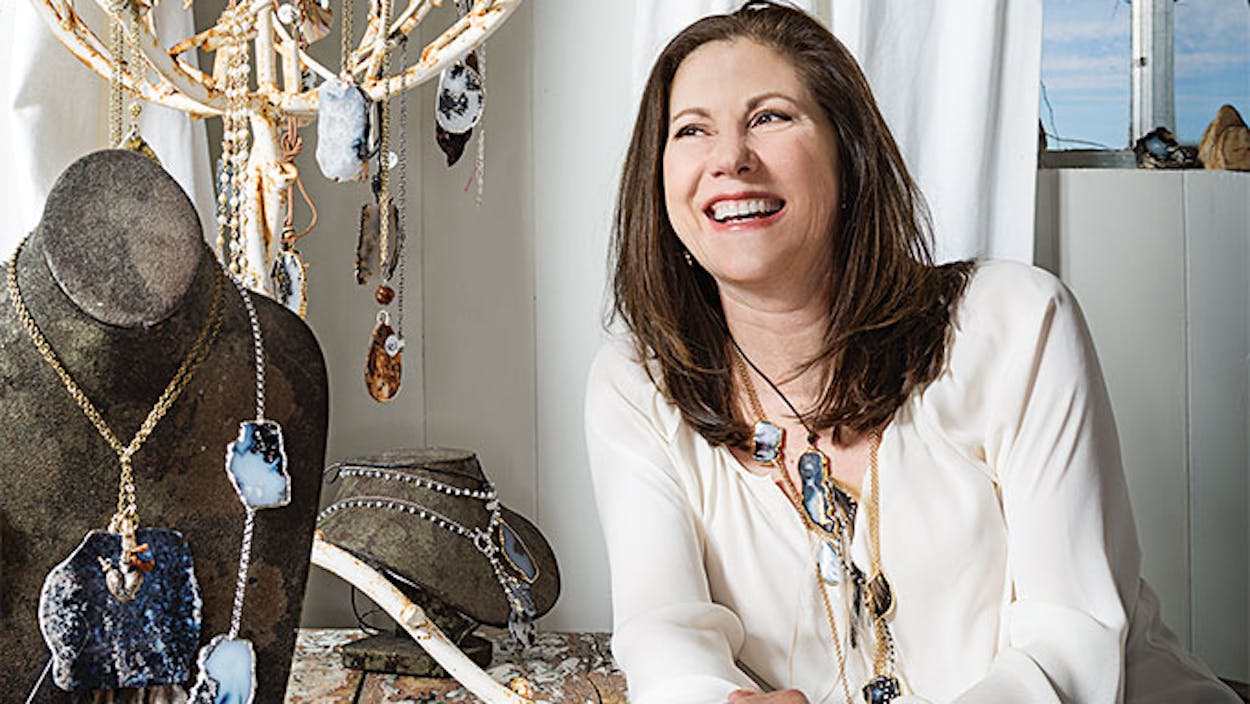N early every day that she’s at her ranch, on the edge of the Chihuahuan Desert, Kathy Bracewell heads out on foot or by pickup truck to roam her spread. Her favorite times are dawn and dusk, when the light is just right for spotting the dark-gray and black patches of ground that let her know there’s a bed of agate lying there waiting to be discovered. A jewelry designer and former interior decorator who divides her time between West Texas and her hometown of Houston, Bracewell was actually searching for something else when she learned that her land was rich with the semiprecious stone. “When the whole thing started, I was looking for Indian artifacts,” she says in her thick drawl. Soon she began working with the rock, stringing polished slices on gold and silver chain and leather cord and adding tiny tin milagros, feathers, and antique rosary beads to make necklaces for herself and friends. Four years later, Bracewell is taking her jewelry company national. But even as her business expands, it’s the hunt for agate that remains her passion. “Oh, I’m out there for hours,” says Bracewell. “My husband’s had to come look for me a couple of times.”

Q&A with Kathy Bracewell
What originally brought you to Marfa?
My husband Brad’s maternal great-grandparents ranched there and are buried in the Marfa cemetery. He’d visited the area often and truly loved it, so he wanted to share it with me. We bought our ranch in 2004.
Have you ever been surprised by rattlers when you’re rock hunting?
I’ve never turned over a rock and had something sitting there, but let’s just say I’ve shot quite a few snakes.
So you carry a gun?
I carry a .38 Special with rat shot from March to November, when the rattlesnakes are up. My daughter-in-law found me a U.S. Marine Corps–grade gun holster made out of an old Louis Vuitton bag, and now I use it all the time when I’m out there.
What does the agate look like when you find it?
Agates have several surfaces. Sometimes you’ll see a rough texture, or sometimes a white outer layer that has the appearance of sea foam on a beach. The white ones are common to the area where we ranch, and they seem to be my favorite. I look for a bubbly surface, caused by lava flow millions of years ago as the stone developed. There may also be watermarks, where the stone lay in water and made beautiful layered lines. Once you cut the stone, you’ll see what are called inclusions, which are interesting shapes formed by minerals. Sometimes the inclusions are black, and the ones with more colorful inclusions, known as bouquet agates, are the most rare for the area.
How do you take an agate from its raw state to jewelry-ready?
First I take them to Paul Graybeal, who has a business called Moonlight Gemstones, in Marfa. He cuts the stones with lapidary saws, and after they’re cut, I polish them at his shop. Polishing is a five-step process, done with different grades of sandpaper and ending with a chamois.
Do you have a piece of your jewelry that you wear all the time?
There is only one piece I have kept for myself, although I could have sold it off my neck. It’s on leather cord, and it’s one of the first pieces I made. It’s a colorful agate with a pom-pom-shaped inclusion, along with something that looks like a heart and a soaring bird around a natural crystal starburst.
And did you ever find any Indian artifacts?
Yes! I’ve found lots over the past ten years. The Indians roamed the creek beds that run through the area, and I sometimes find myself thinking of them—how they interacted with the raw beauty of the area and used those agates to make things, like arrowheads, spearpoints, and scrapers.
For more information, go to agateranchmarfa.com.








